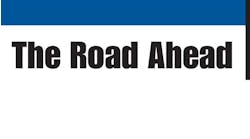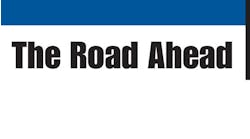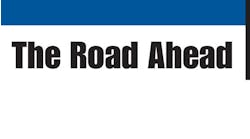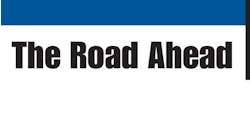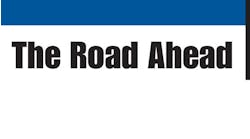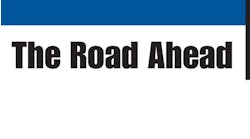Imagine that you have been in the waiting room of your doctor's office for about a year. The receptionist calls you to the counter and explains that the doctor might be able to see you and solve your problem later in 2008. Maybe. But either way, it's looking good for sometime in 2009.
That's pretty much the picture Stephen Latin-Kasper painted in his Truck Equipment Market Outlook at the Business and Market Planning Summit in Rosemont, Illinois. The industry is basically in the waiting room.
It isn't fun. But it's necessary.
Latin-Kasper, market data and research director for the National Truck Equipment Association, said the forecast pros (moderate interest rates, moderate core inflation, low unemployment, increasing trade state and local revenues) will outweigh the cons (terrorism-related lack of confidence, federal budget deficits, high energy and foot inflation, low productivity growth, and capital expenditures).
“There will be some slow growth in 2008 moving forward,” he said. “It's not going to be a great year. The second half will be better than the first. We're all waiting for 2009.”
Latin-Kasper said the truck-equipment market took a “substantial downturn” in 2007, with total transportation and truck-equipment shipments declining $19 billion to $108.8 billion. Every segment saw a decrease, with the biggest coming in trucks and truck chassis (17% to $67.2 billion). Also, truck-equipment shipments, which had increased 9.6% in 2006, fell 10.4% in 2007 to $41.6 billion.
“This pretty much drives the industry,” he said. “What the OEMs get up to is pretty much what the rest of us end up having to deal with. If programs change, we're to go along with the programs changing. If they start to move into other countries and bring their suppliers with them, generally you're going to say, ‘OK, I'm ready to go to that country.’ ”
He said trailer production and American Truck Associations freight shipments have been following each other. Freight shipments peaked at the beginning of 2005, followed by trailer production at the end of the first quarter. Freight shipments plunged into negative territory in the middle of 2006, followed by trailer production in the middle of 2007.
“It's showing no signs of turning up yet,” he said.
Likewise, North American factory shipments of straight trucks (Classes 7-8) and tractors (Class 7-8) have closely followed retail sales. All of them peaked in the third quarter of 2006 and have plunged steadily since then.
“From the end of '05 until now, there was never a big inventory gap,” he said. “The people producing tractors had a real good idea of what was going on with their retailers and we never saw a glut of inventory. They did a really good job of managing inventory.
“As bad as it feels because we got used to those high levels at the end of '05 and in '06, we've gotten back to production levels that were similar to '04. We aren't far from normal right now. It doesn't feel good. A lot of companies have had to cut back because the percentage growth rate has come way down from the end of '04, but we aren't far from normal in terms of actual production levels.”
He broke down the application markets for truck equipment: construction (22.6%), transportation (16.7%), rental (10.6%), government (10%), couriers (8%), distribution (6%), agriculture (5%), utilities (5%), mining (4.6%), manufacturing (4.6%), retail (4.5%), and other services (2.4%). He said the rental market has been growing over the past five years.
He said state and local government spending on equipment has steadily increased since the beginning of '06.
“State and local government became an area of opportunity in '07,” he said. “If you haven't already been focused on state and local government, you need to. Through '08, state and local governments should be a good place to look for business, whereas many of the other markets we are used to looking at — construction, utilities — aren't quite performing the way we'd like.”
He said that when analyzing producer price indexes for steel and steel products, it is beneficial to look at carbon steel scrap. He said it gets “volatile in a hurry” because when there's a shortage of new steel, it's easier to make it from old steel, and the demand for that goes up quickly when companies are trying to quickly ramp up production.
He said that although carbon steep scrap increased 14.85% between August '06 and August '07, it increased just 1.6% in the final quarter of that period.
“If that (14.8% increase) had carried through into the third quarter, we would have been worried about pricing for steel in '08,” he said. “But it looks like it's not going to be a big deal.
“The pricing environment has not been bad, and in some cases it's actually improved. Right now, we're not seeing an indication of steel prices going up anytime soon. In fact, there is a fair amount of new steel production capacity coming on line — not just here in the US, but around the world. Because of that, there is no expectation that I've heard of steel prices increasing in '08. But as you know, that can change in a hurry.”
He said there should be more concern about aluminum plate, because its price index increased 6.4% in the final quarter of that period.
And there should be even more concern about diesel prices, which late in 2005 intersected with the ATA Freight Index for the first time in over 13 years.
“We now have to be concerned that we might get to a place where we can, economically speaking, no longer absorb any additional price increase without causing significant damage to economic growth. We aren't there yet. But we could get there. It's not going to happen in '08 or '09, but things are looking worse.
“The demand for hybrid vehicles is coming from the diesel-price increase. There's always been a technological factor built into the whole process of competition. And that's what's going on with hybrids now. Everybody sees the opportunity, so all of us are going to be dealing with new technology in the very near future.”
Latin-Kasper said Mexico is continuing to close the gap on Canada as the country from which the US imports the most goods. In 2006, the US imported $12.2 billion from Canada and $9.5 billion from Mexico, with Japan a distant third at $1.1 billion. But last year, the imports from Canada fell to $11.8 billion while the imports from Mexico increased to $9.8 billion.
“We can't continue to think that they are going to remain our top two import-export trade partners within this industry, because there are trends elsewhere in the world that are going to impact that,” he said.
He said US exports of trucks, buses, bodies, and other truck equipment to China are “very healthy and getting healthier.” In 2007, our exports to China more than doubled to $295 million, while exports to Latin America were up 28% to $1.07 billion.
“That is some pretty amazing growth, and Latin America is not that far away,” he said. “Most of the OEMs are already there. There are a number of ways to get there as far as expanding your sales to Latin America. And you can't afford not to start looking at Asia. The numbers make it clear that you will be able to grow faster there than you are here.”
How will weather patterns in the US affect the market? A lot, he said, especially in snow and ice control. He said we have moved from El Nino into La Nina.
“We would expect La Nina to hang around for about five years, which means the Northwest and upper Midwest are going to get a lot more days of two inches or more of snow,” he said. “La Nina typically is good for the snow control guys.”
Latin-Kasper said that according to Global Insight, retail sales of trucks and tractors are projected to increase modestly in the next two years in most classes, and dramatically in Class 8: Class 1-2, 1,758,919 in '07 to 1,760,000 in '08 to 1,786,400 in '09; Class 3-5, 248,151 in '07 to 252,010 in '08 and 267,400 in '09; Class 6-7, 128,339 in '07 to 132,400 in '08 to 160,950 in '09; Class 8, 150,000 in '07 to 155,000 in '08 to 250,000 in '09.
Truck and Trailer Industry Forecast
Presenter: Martin Labbe, president/CEO, Martin Labbe Associates LLC
He said Class 8 continues to show instability and the Class 6-7 markets are weakening due to the housing downturn, but state and local could pick up the slack.
“Consumers are securing the hatches,” he said. “Wage gains do exceed inflation, but consumer wealth for too many is in decline. Consumers did adjust to higher fuel prices, but not at $85 per barrel for crude.”
On the Class 4-5 population impact, he said the first-owner population is five years old or less and will grow by 40% in four years, while the primary second owner population is six to 10 years old and will not grow in the next four years. The result: extended life for the original owner. Depreciation is not a major factor in commercial ownership; productivity is.
He sees the following Class 4-5 use changes: more cargo-oriented equipment; service vehicles remain primary use; a developing secondary market; alternative use will be determined by retrofit; an expanded current OEM/body interface.
He says the average fleet size is growing, wholesale/retail distribution use will gain, for-hire will make inroads into private, and public warehousing will shape distribution.
Labbe said the total Class 6-7 miles are increasing by 10% per year, with the Class 7 tractor the primary cause. He anticipates that the housing downturn will hurt demand for construction and short-haul service applications, and regional distribution will continue to increase.
He sees a slight increase in fleet size, a decrease in productivity due to congestion, a balanced used truck market, and a major adjustment in equipment durability for the end user.
On the Class 6-7 population impact, he said the first-owner population is five years old or less and will not grow in four years; the primary second-owner population is six to 10 years old and will not grow in four years. The results: a stable supply of equipment for the second owner, and low mileage and high economic life.
Labbe said the Class 8 used truck market was impacted by a pre-buy wave and the EOBR issue; the period of ownership will need to increase for new trucks; and it's not a short-term issue.
He described these Class 8 use changes: greater average annual miles are at risk; the engine impact will increase lifetime miles for current equipment; fleets may move to contracted in-shop service; and private carriage will be a declining share of new truck buyers.
His Class 8 tractor fleet profile includes increased consolidation and specialization; a driver shortage that continues to be a problem; and key issues of equipment utilization and driver recruitment.
On the Class 8 population impact, he said the first-owner population is five years old or less and will increase in the next four years, and the primary second-owner population is six to 10 years old and will decline in the next four years. The result: far too many used trucks are heading to the market and will be for some time, so it's time to export.
“Freight will slowly grow for the next six quarters,” he said. “Fuel prices are at record highs. Driver wages will increase 25% by 2009. Insurance increases will be 15% per year. And 60% of operating costs will increase in excess of 15% per year.”
He said trucking utilization must improve, driver wages will force cost containment, mergers and acquisitions will increase, and investment should be made in things other than equipment.
His conclusions:
-
Many fleets will disappear in next two years.
-
Be prepared to offer equipment that is very use-specific.
-
Look to have first owners hold on to equipment for more of its economic life.
US Regional Economic Forecast
Presenter: Mark Vitner, senior economist/director of corporate banking, Wachovia Corp
Vitner said the US is in the midst of a mid-cycle adjustment — an expansion that is nearly six years old and features drivers of economic growth that are changing.
He said home sales peaked about two years ago and are now more than halfway through a major correction, with sales expected to bottom out at the end of 2007 and residential construction bottoming out in 2008.
Consumer spending is growing more modestly due to slower home-price appreciation and higher fuel prices, he said. Spending will grow slightly below income growth, meaning retail sales should rise at a 5% pace.
“Forecasts of outright declines are way off the mark,” he said.
He also said worries about a tidal wave of defaults coming out of the $567 billion in ARMs re-pricing in '07 are “overblown,” adding that nearly two-thirds of these loans already have been paid off.
Vitner said business fixed investment and net exports need to pick up to bring the economy back to above trend growth, and both are “moving in the right direction.”
He gave this US economic overview:
-
The economy had solid momentum going into the subprime mortgage crisis.
-
We have scaled back our estimate for consumer spending and are now looking for a slightly larger drop in homebuilding.
-
Business fixed investment is now expected to rise less rapidly but will still improve.
-
Hiring has moderated recently but remains reasonably strong outside of manufacturing and residential construction.
-
Exports have risen nearly as fast as residential construction has fallen, providing a strong positive offset.
-
Worries about a negative wealth effect appear to be overblown. The wealth effect is believed to be, at most, 3-4% over a two-year period.
-
Housing prices are still rising in metro areas containing 80% of the US population and will likely fall only modestly in the aggregate.
-
Past experience suggests spending will not fall, it will merely rise less rapidly than after-tax income.
-
Unemployment remains below what is normally referred to as full employment.
-
Over the long run, nominal GDP and Treasury yields should align. Declining core inflation has given the Fed room to ease if it becomes necessary in coming months.
-
Growing volumes of international trade have boosted demand for space near major seaports. Inland ports, such as Atlanta and Dallas, continue to have relatively high vacancy rates but mostly from older generation space. With goods coming in by the boatload, businesses needed larger footprints and much more parking lot space for containers.
]Truck Application Market Forecast
Presenter: Eli Lustgarten, senior vice president, Longbow Securities
Lustgarten said that over the past few months, the US economy has taken several shots that have created significant volatility in the stock market and threatened to send many companies and investors searching for cover.
But despite significant body blows from the housing recession, $3-plus-per-gallon gasoline and near $80-per-barrel oil, and the sub-prime meltdown, the domestic economy managed to show a sharp rebound in economic growth in the second quarter of '07.
He said the second-quarter GDP was initially reported at 3.4% (now revised to 3.8% from 4%), compared to a revised 0.6% (from 0.7%) in the first quarter, and the consensus forecast for GDP growth in the second half of '07 remained at 2% to 2.5% (though down from 2.5% to 3%).
“Several key trends are currently driving the industrial sector,” he said. “In general, the US economy is regaining momentum after a very slow start for the year. Inventory liquidation seems to be running its course. The residential construction and automotive markets in North America continue to be weak but may be viewed as approaching a market bottom as we anniversary the big declines that started last year. Non-residential construction in North America remains solid. The farm economy continues to be driven by the ethanol complex, even as corn plantings reach near-historic highs, and despite likely yielding higher carryovers, somewhat lower prices, and a mixed picture for farmers in the equipment sector.
“Looking into the second half of '07 and the first half of '08, the trends in labor markets to date show that the consumer is receiving support from income growth, the manufacturing sector is springing back to life, and business seems poised to expand operations and increase capital spending.”
He said consumer spending softened in the second quarter of '07, rising only 1.4% — the slowest increase since the first quarter of '05. He believes that the healthy job markets (until now) suggest that the shortfall may have more to do with the surging price of gasoline rather than the ability to spend as price averages of over $3 per gallon were cutting deeply into the buying power of income.
“The economy continues to generate jobs at a rate sufficient to keep unemployment around 4.6%, within a whisker of the six year low of 4.4%,” he said. “Manufacturing has come back to life. Businesses are also revving up capital spending; business spending surged 11.0% (revised from 8.2% and 11.1%) in the second quarter, with equipment and software spending rising 4.7% in the second quarter versus a paltry 0.3% in the first quarter. Business construction was up 26.2% (revised from 22.2% and 27.7%), the largest gain in 13 years.”
He said capital spending should strengthen in '08 and beyond:
-
Demand remains relatively good both here and abroad.
-
Capacity utilization in manufacturing moved up to around 81% in June 2006 until the fourth quarter, a rate more than 1% above its 1972-2005 average of 79.8%. The current fall-off in activity is about back to the average.
-
Corporate cash flow and profits remains strong; balance sheets are in “terrific shape.”
-
Global markets and US competitiveness overseas should continue, helped by the weakening dollar.
“Look for improving domestic economic growth,” he said. “The current economic data is supportive of our forecast for an improved domestic economy through 2008. It is still likely to be a two-tier domestic industrial recovery. We do not expect much more than stabilization for the truck sector, construction equipment (with residential markets at best stabilizing), and auto. Most other industrial sectors should show modest improvements, with the real strength in the industrial economy still outside the US.
“While core inflation has subsided to levels tolerable by the Federal Reserve, the stronger-than-expected second-quarter GDP report and expectations for more normal GDP growth in the second half of 2007 will continue to pressure the labor markets. The dollar remains under attack with stronger economic growth still expected outside the US. The recent broadening of the financial crisis related to sub-prime lending, potential further weakening in the housing sector, and recent problems at selective hedge funds has again caused the futures market to factor in a rate reduction in September (50 BPS actual), and perhaps at least a second by year end.”
He said the cyclical truck boom of 2006-2010 has been driven by a normal cyclical economic recovery, assuming sustained 3% domestic GDP growth, and exacerbated by the fear of 2007 emissions, causing rational truck owners to dramatically reduce fleet age as much as possible by January 1, 2007.
“The freight decline in 2006 of 2.8% may mean that the trucking industry overbought by as much as 110,000 trucks in 2006,” he said. “Heavy-truck demand will fall at least 40% to 50%; medium trucks saw a 20% to 25% decline in 2007. The current environment is characterized by weak freight and weak pricing. There is a U-shaped recovery for trucks, at best. The engines that fleets hate in 2007 will hopefully be loved in 2008 and 2009; 2007 engines are 2002 engines with added filtration. 2010 emissions standards are very stringent and difficult, causing material engine and truck re-designs.”
He said there are too many trucks chasing too little freight.
“ATA truck tonnage was down 1.6% for 12 months ending June 2007 and down 0.5% for the six months ending June 2007,” he said. “The cost of operating 2007 trucks was up about $0.04 to $0.045 per mile. The fuel economy of 2007 engines was down about 2% from older models, despite OEM claims, plus maintenance of $1,000 per year adds about $0.02 per mile. A higher capital cost, $7,500-$10,000, added $0.02 to $0.025 per mile. Trucker revenue of $2 per mile in 2006 showed weakness in the first half of 2007. A net profit margin of 5% in 2006 may be closer to 4% in 2007.
A projected 2008 recovery may be more muted: 250,000-plus units.”
North American Macroeconomic Forecast
Presenter: William Strauss, senior economist/economic advisor, Federal Reserve Bank of Chicago
Strauss said the economy entered its sixth year of expansion, even though residential investment growth fell off sharply, subtracting nearly a full percentage point-off of GDP growth over the past year.
“Inflation moderated beginning in the second half of 2006,” he said. “Oil prices are near all-time highs. However, adjusted for inflation, current oil prices are well below early-1980s prices. Expenditures on energy increased over the past few years. However, they remain below the historical average. Employment increased by over 1.6 million jobs over the past 12 months, averaging 135,800 jobs per month. Although it has been edging higher, the unemployment rate remains low. Income growth has been rising. The stock market continues to rise. Consumer spending growth remains solid.”
On the housing market, he said: the supply of new single family homes remains elevated; housing starts have been declining; mortgage rates remain low; home-price declines appear to be moderating; home sales have fallen sharply; housing affordability remains low; consumer attitudes for buying a home remain low; the mortgage foreclosure rate has been rising; and mortgage foreclosure increases have also been limited to adjustable rate mortgages and largely in subprime mortgages.
On manufacturing, he said: output growth has been moderating since the middle of 2006; manufacturing output in the US has never been higher; and manufacturing capacity utilization remains relatively high.
“The outlook is for US economic growth to expand at a rate below potential through 2007,” he said. “Employment is forecast to rise, leading to a small increase in the unemployment rate. Credit markets are adjusting quite rapidly, adding a large amount of uncertainty to the outlook. The housing market is expected to remain soft over the coming year and remains the biggest risk on the horizon.”
